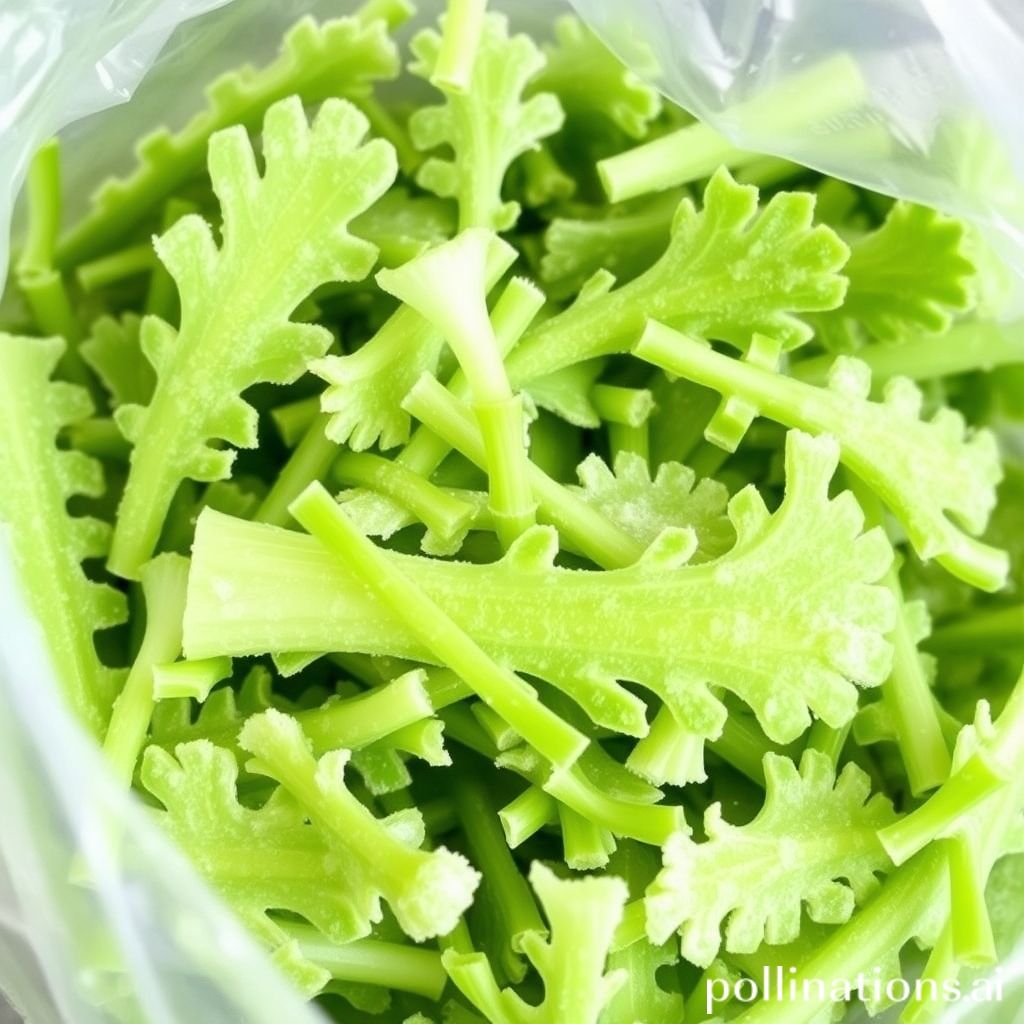Can You Freeze Celery Leaves?
Tired of wasting precious celery leaves that always seem to go bad before you can use them? Well, here’s a game-changing solution: freezing them! By freezing celery leaves, you can not only extend their freshness but also reduce food waste. In this article, we’ll delve into the benefits of freezing celery leaves and guide you through the simple process.
Get ready to unlock a world of convenience and flavor as we reveal the secrets to preserving and using frozen celery leaves. Say goodbye to wilted greens and hello to a kitchen hack that will revolutionize your cooking!

Table of Contents
Understanding Celery Leaves
Characteristics and Uses of Celery Leaves
Celery leaves are an integral part of the celery plant, often overlooked but offering unique characteristics and various uses. These vibrant green leaves, attached to the celery stalks, possess a distinct flavor profile that adds depth to dishes. Rich in essential oils, celery leaves provide a refreshing and herbaceous taste, similar to their stalk counterparts but with a slightly stronger and more concentrated flavor.
Celery leaves are versatile in culinary applications and can be used in numerous ways. They make an excellent addition to salads, soups, stews, and stir-fries, enhancing both the taste and visual appeal of the dishes. Their delicate texture and bright color also make them a popular choice for garnishing plates, adding a touch of freshness to the overall presentation.
Nutritional Value and Culinary Applications of Celery Leaves
Celery leaves are not only flavorful but also packed with essential nutrients. They are a good source of vitamins A, C, and K, as well as folate and potassium. These leaves are also rich in antioxidants, which help protect the body against oxidative stress and inflammation.
In terms of culinary applications, celery leaves can be used as a substitute for parsley in many recipes. They can be finely chopped and sprinkled over dishes to add a bright and herbaceous flavor. Additionally, celery leaves can be blended into pesto or incorporated into green smoothies for an extra nutritional boost.
To make the most of celery leaves, proper storage is essential. If you have an abundance of fresh celery leaves, freezing them can be a convenient option. By blanching the leaves briefly and then freezing them in an airtight container, you can preserve their flavor and use them in your recipes whenever needed.
In conclusion, celery leaves are a versatile ingredient with unique characteristics and various culinary uses. Their nutritional value and distinct flavor make them a valuable addition to a range of dishes. Whether you choose to use them fresh or freeze them for later, celery leaves are a delightful way to elevate your culinary creations.
Expert tip: Enhance your dishes with the versatile flavor of celery leaves. Use them in salads, soups, and as a garnish for a fresh and vibrant touch.How to Prepare Celery Leaves for Freezing
A. Step-by-Step Instructions for Preparing Celery Leaves
- Harvest fresh celery leaves from the plant: Carefully pluck the leaves from the celery plant. Make sure they are fresh and vibrant.
- Remove any damaged or discolored leaves: Discard any wilted, damaged, or discolored leaves.
- Rinse the leaves thoroughly under cold water: Place the celery leaves in a colander and rinse them under cold running water to remove dirt, insects, or debris.
- Pat the leaves dry: Gently pat the leaves dry using a clean kitchen towel or paper towels. Remove excess water to prevent ice crystals during freezing.
B. Importance of Properly Washing and Drying the Leaves
Properly washing and drying celery leaves before freezing is crucial to ensure the best quality and taste after thawing. Here’s why:
- Washing the leaves ensures that they are clean and free from any contaminants: Rinsing the leaves under cold water removes dirt, insects, or chemicals on the surface.
- Drying the leaves helps prevent ice crystals from forming during freezing: Excess moisture on the leaves can cause ice crystals, affecting the texture and flavor when thawed. Thoroughly drying the leaves removes moisture and reduces the risk of ice crystal formation.
By following these simple steps to prepare celery leaves for freezing, you can ensure their freshness and quality for longer periods. This allows you to enjoy their flavor in various dishes throughout the year.
| Key Points: |
|---|
| – Harvest fresh and vibrant celery leaves |
| – Remove damaged or discolored leaves |
| – Rinse thoroughly under cold water |
| – Pat dry to remove excess moisture |
Methods for Freezing Celery Leaves
Flash Freezing: Pros and Cons
One popular method for freezing celery leaves is flash freezing. This technique involves spreading the leaves in a single layer on a baking sheet and placing them in the freezer until fully frozen. Flash freezing retains the vibrant green color and crisp texture of the leaves, making them visually appealing and preventing them from becoming mushy or limp. It also allows for easy portioning, as the leaves do not stick together when frozen individually. However, flash freezing requires a significant amount of freezer space and can be time-consuming, especially for large quantities of celery leaves.
Blanching: Pros and Cons
Another commonly used method for freezing celery leaves is blanching. Blanching involves briefly boiling the leaves in water and then transferring them to an ice bath to stop the cooking process. Blanching preserves the color, flavor, and nutritional value of the leaves while slightly softening them for easier handling. It also helps eliminate any bacteria or insects present on the leaves. However, blanching may result in a loss of some nutrients as they can leach out into the boiling water. It is important to blanch the leaves for the appropriate amount of time to avoid overcooking and a mushy texture. Additional steps like drying the leaves thoroughly before freezing may be necessary to prevent ice crystal formation.

Can You Freeze Celery Leaves?
Proper Storage of Frozen Celery Leaves
Properly storing frozen celery leaves is crucial to maintain their freshness and quality. Follow these tips to ensure that your frozen celery leaves retain their flavor and texture:
| Tips for Storing Frozen Celery Leaves |
|---|
| Blanching: Before freezing, blanch the celery leaves in boiling water for 1-2 minutes. This preserves their color, texture, and flavor. |
| Cooling: After blanching, transfer the celery leaves to an ice bath to stop the cooking process. This helps maintain their crispness and prevents them from becoming mushy. |
| Drying: Thoroughly dry the blanched and cooled celery leaves using a clean kitchen towel or paper towels. Excess moisture can lead to freezer burn and diminish the quality of the frozen leaves. |
| Packaging: Place the dried celery leaves in airtight freezer bags or containers. Squeeze out any excess air before sealing to prevent freezer burn and maintain their freshness. |
| Labeling: Don’t forget to label the freezer bags or containers with the date of freezing. This helps you keep track of their storage duration and ensures you use the oldest leaves first. |
When properly stored, frozen celery leaves can maintain their quality for an extended period. It is recommended to use them within 12 months for optimal flavor and texture.
| Recommended Storage Duration for Best Quality |
|---|
| Up to 12 months: For optimal flavor and texture, use frozen celery leaves within 12 months of freezing. While they may still be safe to consume after this period, their quality might gradually decline. |
By following these storage guidelines, you can enjoy the convenience of frozen celery leaves while ensuring their taste and texture remain intact. Incorporate these tips into your freezing routine to make the most out of your celery leaves.
Thawing and Using Frozen Celery Leaves
Thawing Process for Frozen Celery Leaves
To properly thaw frozen celery leaves and ensure the best texture and flavor, follow these steps:
- Remove the frozen celery leaves from the freezer and transfer them to a plate or bowl.
- Thaw the leaves in the refrigerator overnight to retain their crispness.
- If immediate use is needed, place the celery leaves in a sealed plastic bag and submerge it in cold water for about 30 minutes to thaw quickly.
- Gently pat the thawed leaves dry with a paper towel to remove excess moisture.
Creative Ways to Incorporate Frozen Celery Leaves into Recipes
Frozen celery leaves can add freshness and flavor to various dishes. Here are some creative ways to use them:
- Herb-infused oils and butters: Finely chop thawed celery leaves and mix them with olive oil or softened butter. Use this aromatic mixture to enhance sauces, dressings, or as a spread on bread.
- Flavorful soups and stews: Add a handful of thawed celery leaves to soups or stews during the last few minutes of cooking to infuse a delightful herbal note.
- Green smoothies or juices: Blend thawed celery leaves with fruits and vegetables to create nutritious and refreshing green smoothies or juices. They pair well with cucumber, apple, or spinach.
- Stir-fries and sautés: Toss thawed celery leaves into stir-fries or sauté them with other vegetables for a quick and healthy side dish. They add a pleasant crunch and a hint of celery flavor.
- Salads and garnishes: Use thawed celery leaves as a vibrant addition to salads, whole or chopped. They can also be used as a garnish for soups, roasted meats, or vegetable dishes.
By following these thawing techniques and exploring creative ways to incorporate frozen celery leaves into your recipes, you can enjoy the benefits of this versatile ingredient throughout the year. Experiment with different dishes and let your culinary imagination run wild!
Conclusion
In conclusion, freezing celery leaves is an excellent way to prolong their freshness and minimize waste. By following the recommended steps for preparation and storage, you can have a convenient ingredient available for a variety of recipes. Whether you opt for flash freezing or blanching, thawed frozen celery leaves can be used in soups, stews, salads, and other dishes.
With proper handling and storage, frozen celery leaves can become a valuable addition to your culinary repertoire. So go ahead and freeze those celery leaves to enjoy their flavors and nutritional benefits for longer periods.
Faq about Freezing Celery Leaves
FAQ 1: Can Frozen Celery Leaves be Used as a Substitute for Fresh Ones?
Yes, frozen celery leaves can be used as a substitute for fresh ones in most recipes. Freezing may slightly alter their texture, but they can still provide flavor and nutrients to your dishes.
FAQ 2: How Long Can Frozen Celery Leaves be Stored?
Frozen celery leaves can be stored for up to 6 months in the freezer. To maintain their quality, it is recommended to use airtight containers or freezer bags to prevent freezer burn.
FAQ 3: Can Frozen Celery Leaves be Used in Raw Dishes like Salads?
Yes, you can use frozen celery leaves in raw dishes like salads. However, it’s important to thaw them before adding them to your salad to avoid any unwanted moisture.
FAQ 4: Do Frozen Celery Leaves Lose Their Nutritional Value?
Freezing celery leaves may cause a minimal loss of nutritional value, but they will still retain most of their vitamins and minerals. They can still be a good option for adding flavor and nutrients to your dishes.
FAQ 5: Can Frozen Celery Leaves be Used in Soups and Stews Directly without Thawing?
Yes, frozen celery leaves can be used directly in soups and stews without thawing. The heat from the cooking process will help thaw and incorporate the leaves into the dish. Adjust the cooking time accordingly.

